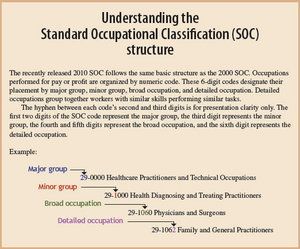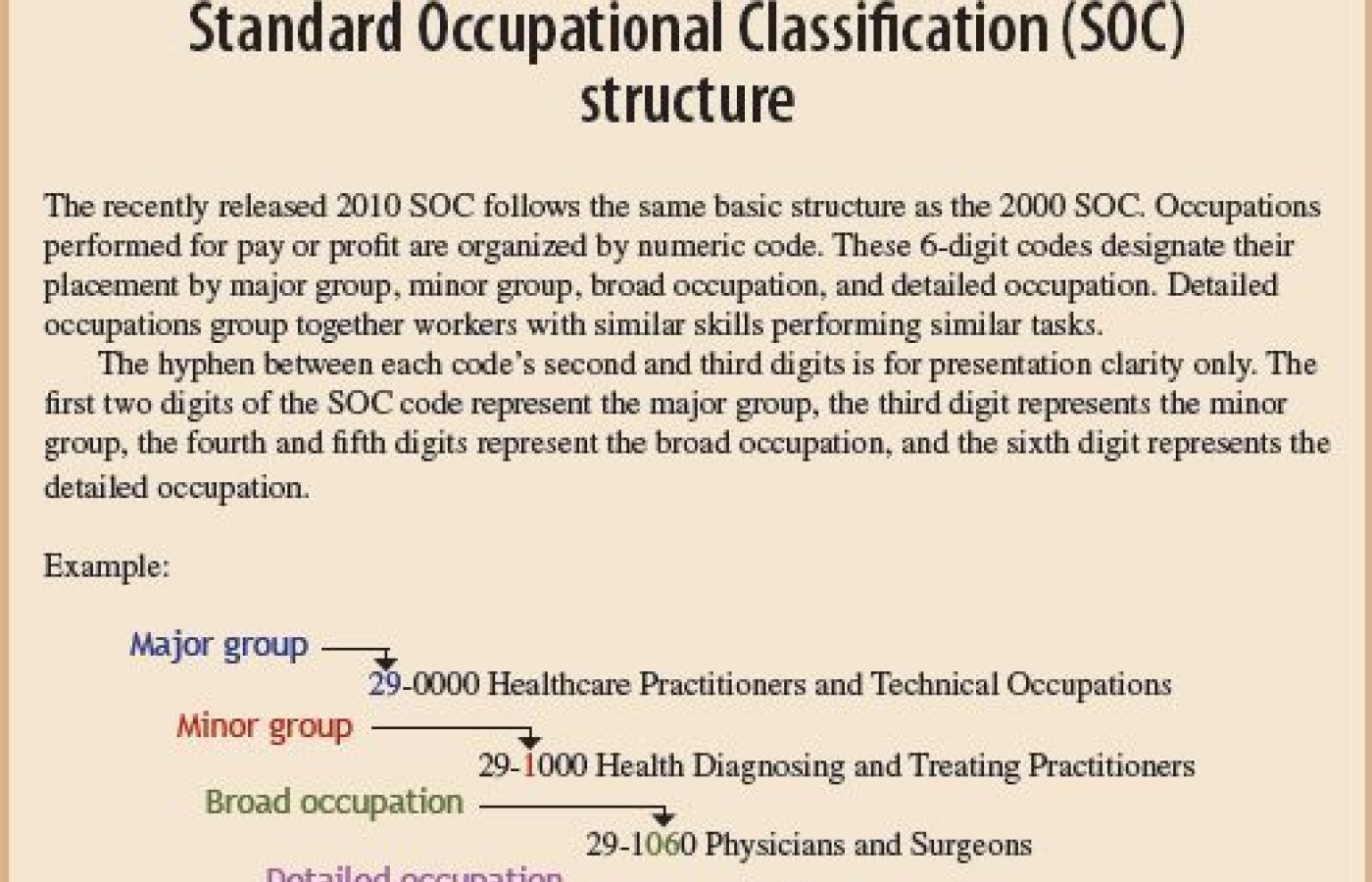Whether you accept it, avoid it or live somewhere in between, insurance coverage has become a defining issue for our profession. Patients increasingly expect to use their benefits, practitioners want to be compensated fairly for their time and expertise, and the system itself remains – at best – fragmented. The encouraging news is that coverage has expanded in meaningful ways. The challenging news is that reimbursement, across the board, remains inadequate.
Gaining an Independent Occupational Code with the U.S. Bureau of Labor Statistics
One of the most important national activities currently taking place in relation to the development of the field of acupuncture and Oriental medicine profession (AOM) is the Department of Labor's Bureau of Labor Statistics' (BLS) revision of the 2010 Standard Occupational Classification (SOC) system. This revision only occurs every eight years, and provides an unparalleled opportunity for AOM profession to gain greater federal recognition. Data collected, classified and published by the BLS is used by the federal statistical agencies to assign workers into occupational categories for the purpose of collecting, calculating, or disseminating data on occupations. This process also lays the groundwork for AOM practitioners to be able to participate in federal loan repayment programs, receive recognition from federal agencies such as the Department of Veteran Affairs, and paves the way for acupuncture services to be included in Medicare, etc.
Early in 2014, the BLS will be soliciting input on proposed changes to the current SOC categories through an initial Federal Register notice (which has yet to be published at the time this article is written). This announcement commences the gathering of input on proposed revisions to the current SOC. Following this announcement, the SOC Policy Committee will meet and draft proposed changes to the SOC. The proposed changes will then be announced to the public through a second Federal Register notice which is expected to publish in early 2015. After that public comment period closes, the SOC will reconvene, consider all the public comments, and the final decisions on the 2018 SOC codes, titles, and definitions will be made available.

The NCCAOM Research Committee and staff are working diligently to gather information, draft a current occupational description, and prepare the draft proposal to submit to the BLS. These steps are crucial in setting the stage for the BLS to classify "Acupuncturists" with an independent SOC code, which would lead to gaining federal recognition and job opportunities for acupuncturists.
Throughout the past several years, there have been a lot of inquiries and perhaps confusion about the impact of the BLS' SOC on the AOM profession. In an effort to fully understand the role that BLS can play with assisting the AOM profession in gaining federal recognition, it is necessary to examine the agency's purpose. The BLS has multiple functions, with its main mission to act as a fact-finding agency for the federal government in the broad field of labor economics and statistics. In order to fulfill this mission, it is charged with collecting data, from each occupation, such as expected growth, job functions, training and education, practice settings, income of workers, and other important trends. This information is then used by the labor force within the profession, those who are interested in entering the profession, and federal government agencies. It tracks each profession by assigning a classification code, and then collects a set of data to measure whether the profession is thriving and/or changing in the United States.
Anyone who has visited the BLS website (www.bls.gov) or happened to glance at the voluminous Occupational Outlook Handbook, which contains a classification of hundreds of occupations in the United States, will agree that it can be quite overwhelming. According to the BLS document, Revising the Standard Occupational Classification System 2012, BLS staff economists Alissa Emmel and Theresa Cosca state "making sense of occupational data is not always easy; therefore, the SOC system utilized by the BLS establishes that organization." Emmel and Cosca add that the SOC "assists federal statistical agencies in organizing the occupational data they collect, tabulate, and analyze. By classifying jobs into occupational categories, the SOC provides a standardized way for agencies to share their data." This report also points out that the occupational data collected is shared by important agencies such as the U.S. Department of Labor, National Center for Education Statis¬tics, U.S. Department of Defense, National Science Foundation, and U.S. Census Bureau; therefore, having a recognition of "Acupuncturists" as an occupation will lead to job classifications within these agencies.
What has been the progress in getting acupuncturists an independent SOC? Before 2010, "acupuncture" was listed a modality under other healthcare professions such as chiropractors and nurses. A search for the term "Acupuncturists" yielded no results. As a result of the collaboration the NCCAOM with the American Association of Acupuncture and Oriental Medicine (AAAOM), the Accreditation Commission for Acupuncture and Oriental Medicine (ACAOM), the Council of Colleges for Acupuncture and Oriental Medicine (CCAOM), Federation Acupuncture and Oriental Medicine Regulatory Agencies (FAOMRA), and the National Acupuncture Foundation (NAF), a proposal, requesting that the BLS recognize the AOM profession was created. This proposal, received by the BLS in 2008, resulted in the BLS's SOC Policy Committee placing "Acupuncturists" in a classification under the major group of Healthcare Practitioners and Technical Occupations (29-0000) and the minor group of Health Diagnosing and Treating Practitioners (29-1000) in 2010. Since 2010, "Acupuncturists" are classified under the "Health Diagnosing and Treating Practitioners, All Other" Major group category (29-000). Please see the figure below for further explanation. The revisions made to the classification system in 2010 can be obtained as part of a special report: [url=http://www.bls.gov/opub/ooq/2010/summer/art02.pdf]http://www.bls.gov/opub/ooq/2010/summer/art02.pdf[/url]. Please see the 2010 Direct Match Title File updated by the SOC Policy Committee in July 2010 (www.bls.gov/soc/soc_2010_direct_match_title_file_sort_dmt.pdf), which lists "Acupuncturists" as a distinct profession to receive a SOC Direct Match Title.
Furthermore, "Acupuncturists" also received a distinct code, 29-1199.01 (a Minor group classification of 29-199 as mentioned above), on the Occupational Information Network (O*NET) Data Collection Program which published the first tracking of the profession on the O*NET website. The O*NET program is the nation's primary source of occupational information. Central to the project is the O*NET database, containing information on hundreds of standardized and occupation-specific descriptors. The database, which is available to the public via their website, is continually updated by surveying a broad range of workers from each occupation. Information from this database forms the heart of O*NET OnLine, an interactive application for exploring and searching occupations. One of the important functions of O*NET, is that it is able to collect descriptive information on occupations that may not meet the criteria to have a distinct and separate code in the existing SOC. This is currently the case for "Acupuncturists". The BLS notified the NCCAOM in 2009 that "Acupuncturists" did not meet Classification Principle 9 (which states that for a detailed occupation to be included in the SOC as an independent profession either the BLS or the Census Bureau must be able to collect and report data on that occupation). "Acupuncturists" was identified for collection as an O*NET "New and Emerging Occupation"; however, O*NET has also labeled "Acupuncturists" with a "bright outlook" logo, , which means that the profession is expected to grow and has a positive outlook. In addition, at the time of this report, O*NET has published a summary report for "Acupuncturists" with identified tasks, interests, work values, wages and employment estimates, based on O*NET's data collection. The URL address http://online.onetcenter.org/help/bright/29-1199.01 will take you to this report.
In anticipation of the upcoming Federal Register announcement, which is a call for proposals for revisions to the 2010 SOC, NCCAOM's CEO, Dr. Kory Ward-Cook and Deputy Director, Mina Larson met with BLS staff and a member of the SOC Policy Committee at the BLS offices in Washington D.C. in December. The BLS staff provided valuable suggestions for refining the current proposal and informed us that information presented to them, to date, was promising. Based on this feedback, NCCAOM will use demographic data from their recent 2013 Job Analysis to prepare the profession's case for an independent SOC, following the 2014 call for proposals to the BLS's SOC Policy Committee. As specified by the BLS staff, the proposal will need to distinguish "Acupuncturists" from other health care providers providing acupuncture treatments, and we need to provide evidence of growth of the profession. It is hopeful that O*NET's data will assist BLS lay the groundwork for tracking the profession which will therefore lead to the decision by the SOC Policy Committee to assign a unique SOC code for 2018. The BLS has recently added a timeline for submitting proposals on their website. See the following link: http://www.bls.gov/soc/#revision for a description of what must be submitted. The NCCAOM Research Committee staff will be following this timeline very closely to ensure that all deadlines are met.
It is important to note that the BLS staff emphasized that the AOM profession work collaboratively to submit a single proposal, as submitting multiple proposals and comments may delay or deter the review process. They stressed that individual public comments are not needed at this time. Since the NCCAOM is working closely with BLS staff, we will notify the AOM national and state organizations when the first draft of submission to the BLS is ready for review. The BLS staff emphasized the desire for one single submission; therefore, support letters will be gathered from national and state organizations in the AOM community to accompany the final proposal. This collaborative process will be similar to how it was done for the AOM profession in 2009.
Within the next 3 to 6 months a follow-up to this article will be submitted to Acupuncture Today. That update will include more information such as when the Federal Register notification occurs and the status of the BLS proposal to be submitted. We are very hopeful that these latest developments will place "Acupuncturists" on the fast track to obtain a unique SOC code in 2018. If you have any questions or need further information, please do not hesitate to contact Mina Larson at mlarson@thenccaom.org.
Reference
- Cosca, T., and Emmel, A (2010). Revising the Standard Occupational Classification system for 2010. Monthly Labor Review. Bureau of Labor Statistics. Washington D.C.



